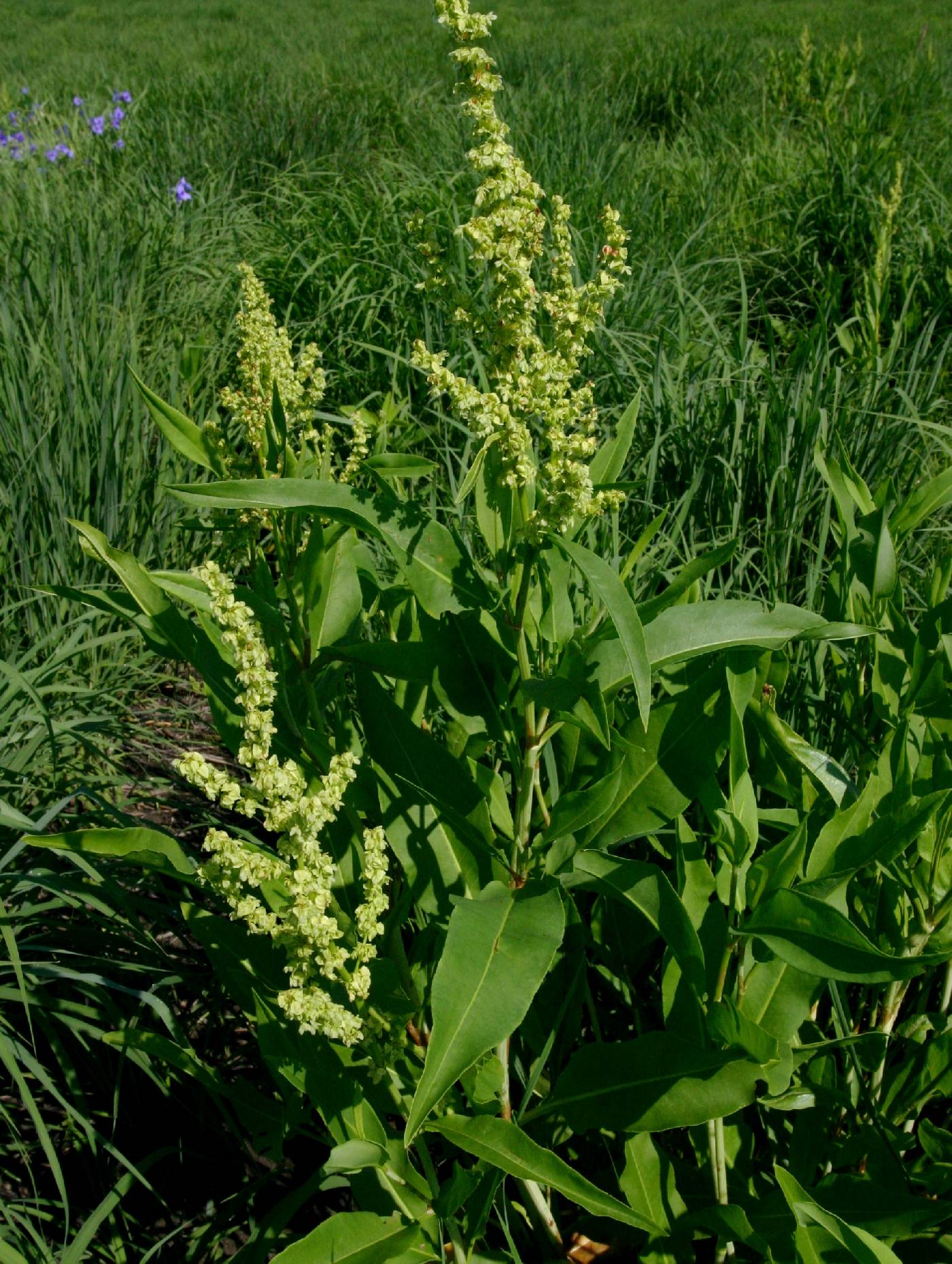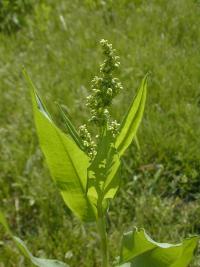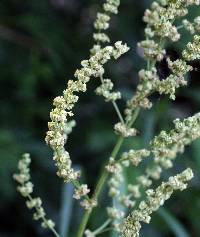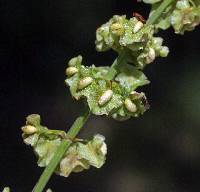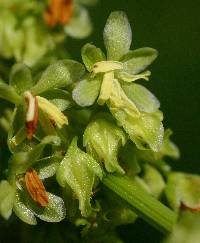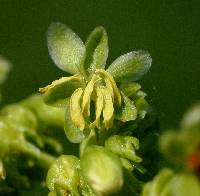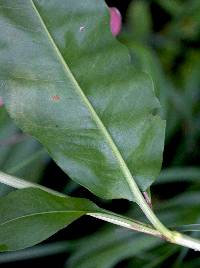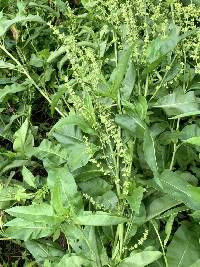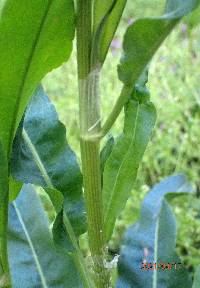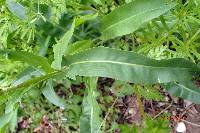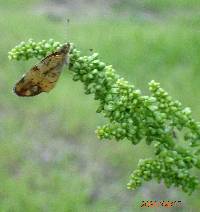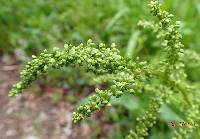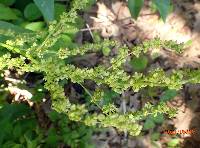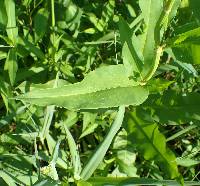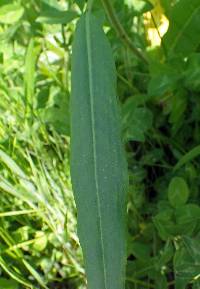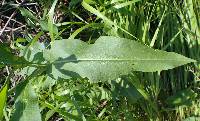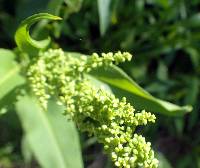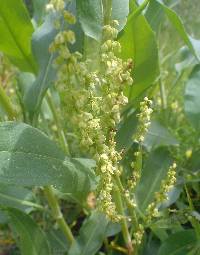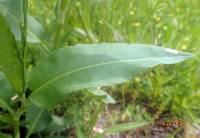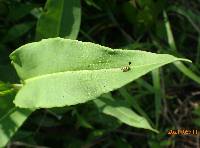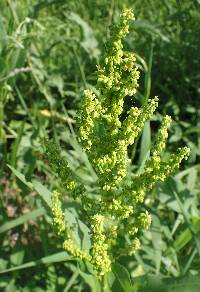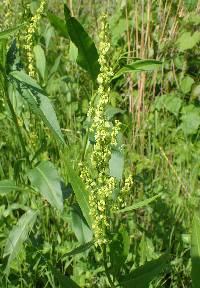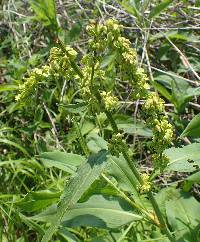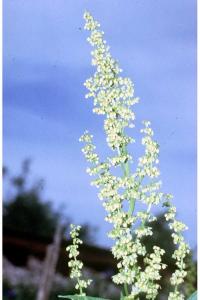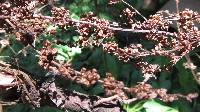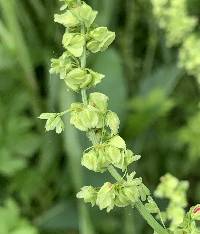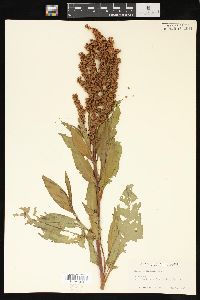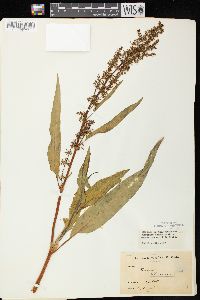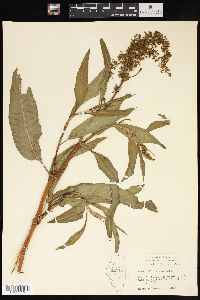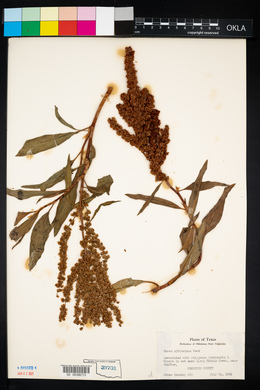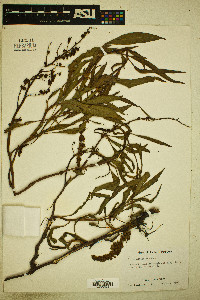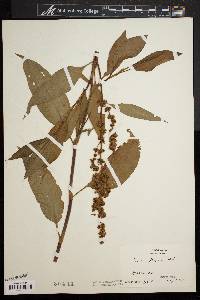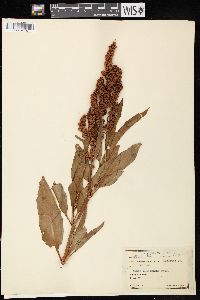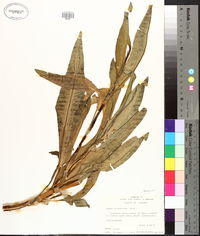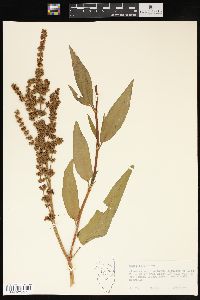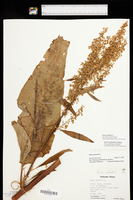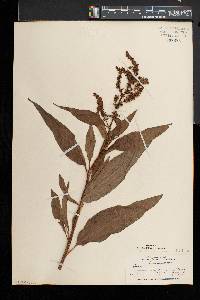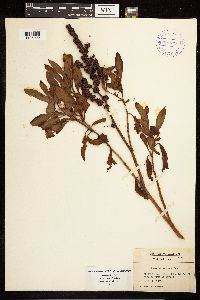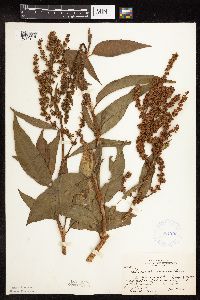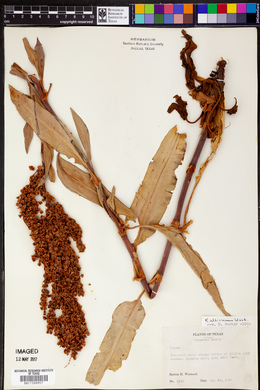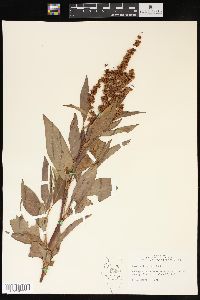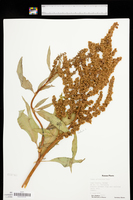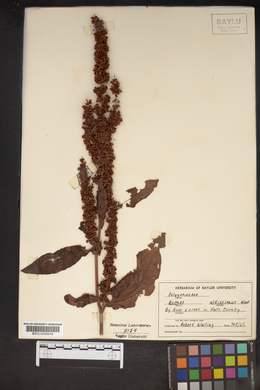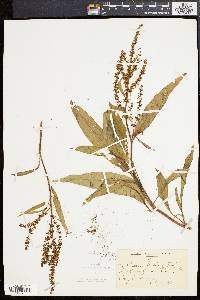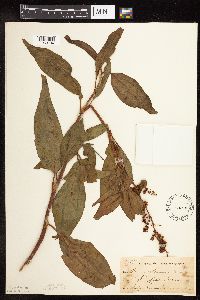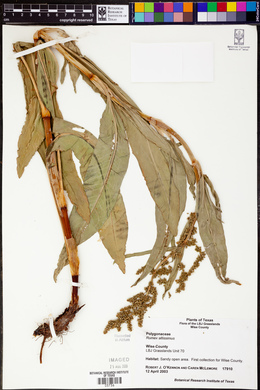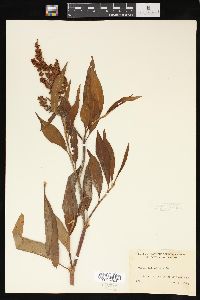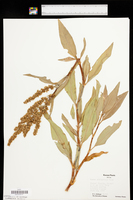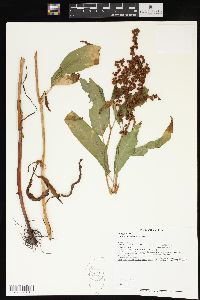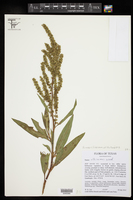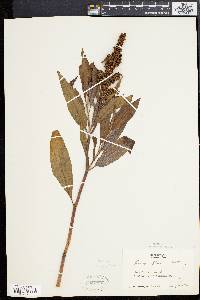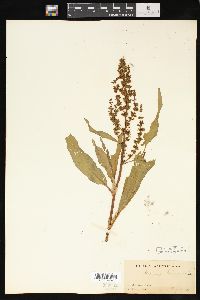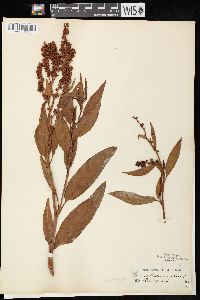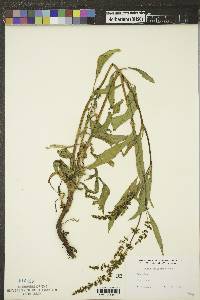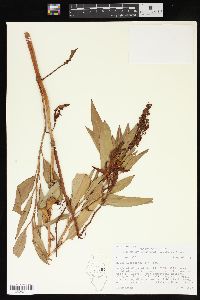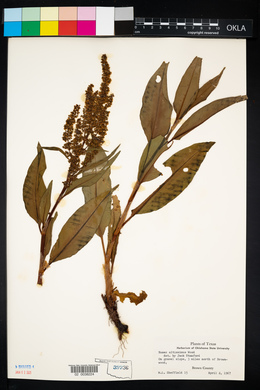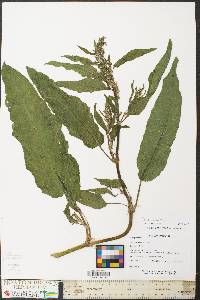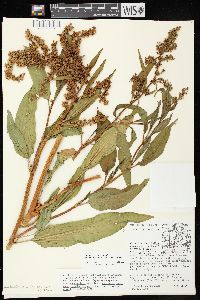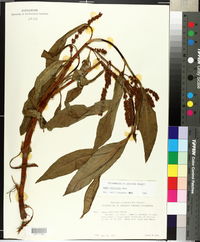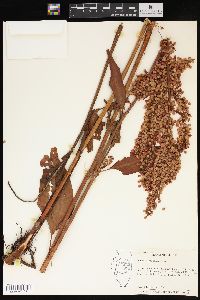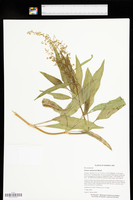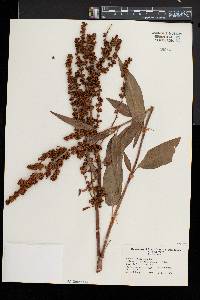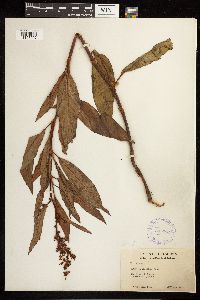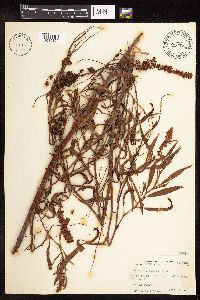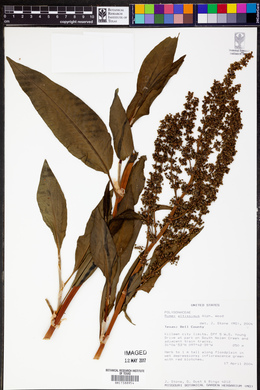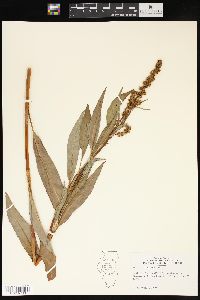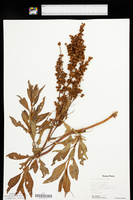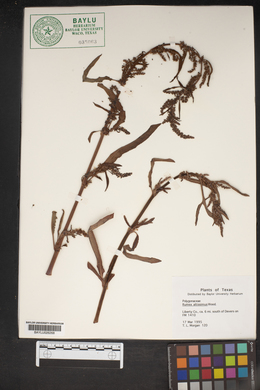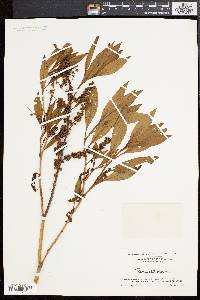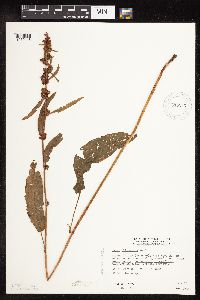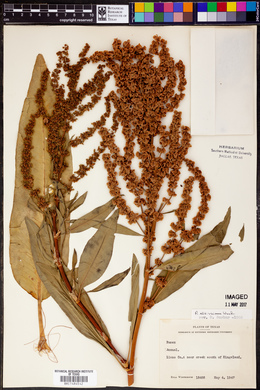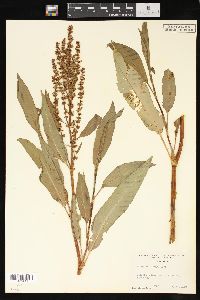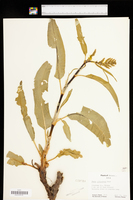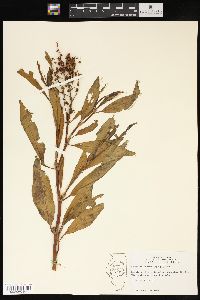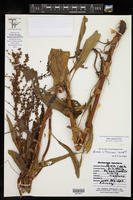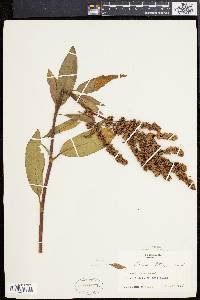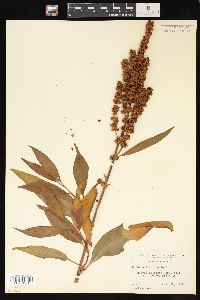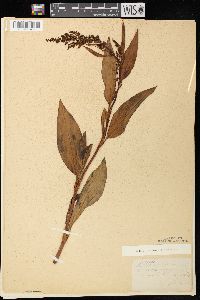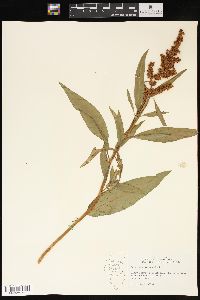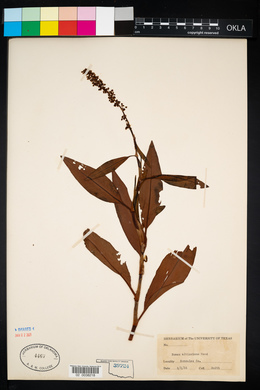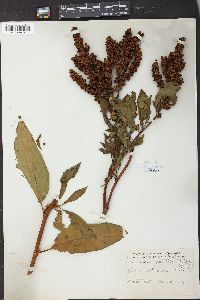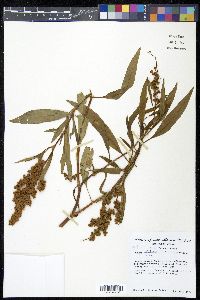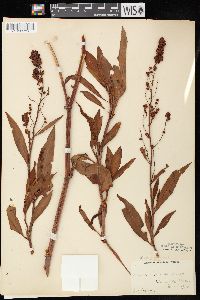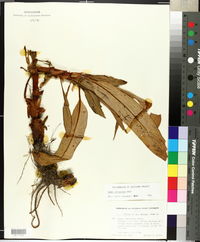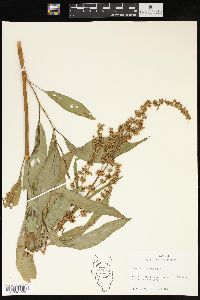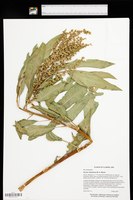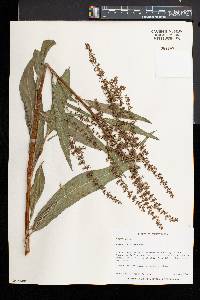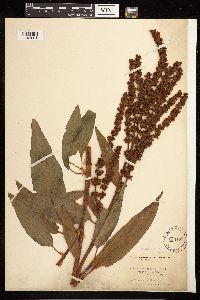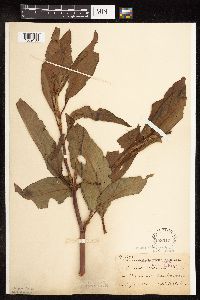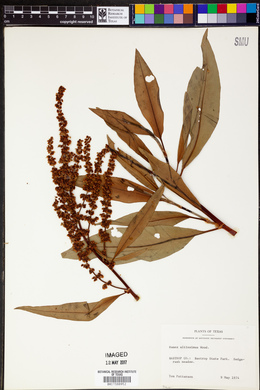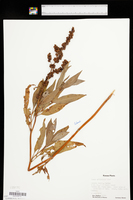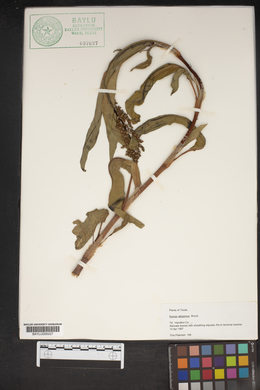Rumex altissimus
|
|
|
|
Family: Polygonaceae
Pale Dock, more...smooth dock
[Rumex brittanicus Meisn., non L.] |
Plants perennial, glabrous, with vertical rootstock. Stems erect, rarely ascending, usually pro-ducing axillary shoots below 1st-order inflorescence or at proximal nodes, 50-90(-120) cm. Leaf blades ovate-lanceolate, elliptic-lanceolate, or lanceolate, 10-15 × 3-5.5 cm, usually ca. 2.5-4 times as long as wide, widest in proximal 2, thick, often subcoriaceous, base broadly cuneate, rarely almost rounded, margins entire, flat, apex acute or attenuate. Inflorescences terminal and axillary, terminal usually occupying distal 1/5- 3 of stem, rather dense, normally broadly paniculate. Pedicels articulated in proximal 1/ 3, sometimes almost near base, thick, (2-)3-7(-8) mm, usually approximately as long as inner tepals, occasionally slightly longer or shorter, articulation swollen. Flowers 12-20 in whorls; inner tepals with broadly triangular, ovate-triangular, or broadly ovate-deltoid, 4.5-6 × 3-4.5(-5) mm, base truncate or indistinctly cordate, margins entire, apex acute; tubercles (2-)3, equal or subequal, glabrous or minutely rugose. Achenes brown or dark reddish brown, 2.5-3.5 × 1.8-2.3 mm. 2n = 20. Flowering late spring-summer. Swamps, marshes, wet shores, alluvial woods, other wet habitats; 0-1800 m; Ont.; Ala., Ariz., Ark., Colo., Conn., Del., D.C., Fla., Ga., Ill., Ind., Iowa, Kans., Ky., La., Maine, Md., Mass., Mich., Minn., Miss., Mo., Nebr., N.H., N.J., N.Mex., N.Y., N.C., Ohio, Okla., Pa., R.I., S.C., S.Dak., Tenn., Tex., Vt., Va., W.Va., Wis., Wyo.; n Mexico; Europe (introduced in Denmark, Sweden, United Kingdom. The name Rumex britannica Linnaeus was misapplied to this species by C. F. Meisner (1856) and some North American authors. Some records of Rumex altissimus from Arizona and New Mexico may refer to R. ellipticus. Two reports from New Mexico were based on misidentification of R. hymenosepalus.
Allred and Ivey 2012, Martin and Hutchins 1980, Correll and Johnston 1970, FNA 2005 Duration: Perennial Nativity: Native Lifeform: Forb/Herb General: Perennial herb, to 1 m tall, from vertical rootstock; stems erect or basally procumbent; herbage glabrous. Leaves: Alternate along the stems, on short sheathing petioles; at the base of each leaf is a thin papery sheath (ocrea) formed by fused stipules, which also wraps around the stem; leaf blades ovate-lanceolate or oblong-lanceolate, 12-18 cm long and 3-5 cm wide, pale green; leaves on the upper stems are smaller. Flowers: Greenish, on nodding pedicels and arranged in crowded whorls in elongate panicles; each flower has 3 outer bract-like tepals and 3 winged inner tepals called valves, about 1 mm wide in flower but enlarging to 4-6 mm long and 3-4 mm wide in fruit, the wings forming a triangular-oval shape; usually all 3 of the valves on each flower have a grain-like tubercle called a callosity. Fruits: Achenes 3-angled, 3 mm high and 2 mm wide, brown or red-brown, surrounded by the 3 enlarged valves (winged inner tepals). Ecology: Found in damp soil, often on waste ground, from 3,500-7,500 ft (1067-2286 m); flowers May-August. Distribution: AZ to WY, east to Ontario, ME, and FL; south to n MEX; also Denmark, Sweden and United Kingdom. Notes: This tall, relatively slender-stemmed Rumex is present but somewhat uncommon throughout the southwest. Distinguish it by the lack of a well defined basal rosette of leaves; the leaf shape which is lance-shaped, widest below the midle, 3-5 cm wide, and never has a pair of lobes at the base of the leaf blade; inner tepals less than 1.5 mm wide when in flower (enlarging greatly in fruit); and flowers on nodding pedicels 3-8 mm long. It is much more common in the eastern US and is also introduced in northern Europe. Ethnobotany: Used to treat stomach cramps, diarrhea, hemorrhages, and boils. Etymology: Rumex is the classical Latin name for dock, possibly derived from rumo, to suck, in reference to the practice of sucking the leaves to allay thirst; altissimus means very tall. Synonyms: Rumex ellipticus, Rumex britannica Editor: AHazelton 2017 Stout perennial to 1 m, often branched; lvs all cauline, pale, flat, lanceolate or more often lance-ovate, acute or acuminate, obtuse or rarely rounded at base; infl loose, 1-3 dm, with usually few short ascending branches; pedicels 3-5 mm, jointed just above the base; valves firm, subrotund, 4-6 mm long and wide, broadly truncate at base; grains 1-3, when plural often unequal, the larger lanceolate, acute, half to two-thirds as long as the valve; 2n=20. Swamps and wet soil; N.H. to Mich., Minn., and Colo., s. to Va., Ga., Tex., and Ariz. Gleason, Henry A. & Cronquist, Arthur J. 1991. Manual of vascular plants of northeastern United States and adjacent Canada. lxxv + 910 pp. ©The New York Botanical Garden. All rights reserved. Used by permission. From Flora of Indiana (1940) by Charles C. Deam Infrequent to frequent throughout the state in low ground along streams and in low ground elsewhere. Peattie observed (Amer. Midland Nat. 10: 130. 1926) that one valve of each fruit had a complete tubercle and a second valve might have an aborted tubercle. He gave this form a name, but if he had read carefully the original description of the species, he would have seen that this phenomenon was included in the description of the species. The tendency to double the number of tubercles is frequent among the fruits of this species. …… Indiana Coefficient of Conservatism: C = 2 Wetland Indicator Status: FACW |
|
|
|

